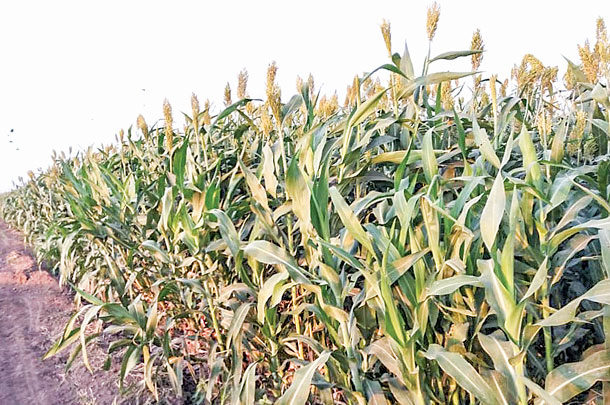Sorghum can be one of the most suitable forages to produce silage in regions with problems of rainfall or irrigation restrictions.
This crop can also be a good alternative when forages are grown on saline soils and high environmental temperatures. However, the nutrient composition of silage made from conventional sorghum varieties have lower neutral detergent fiber (NDF) digestibility. This reduction is the result of the high lignin content in the plant – particularly in the lower portion of the stems.
One management practice available for producers is to cut the plants higher at harvest. This strategy, however, can be controversial because of the reduced forage dry matter (DM) yields, while improving silage quality or vice versa.
Dry matter yield or silage quality
The balance between DM yield losses and sorghum silage nutrient composition must always be considered when leaving more stubble in the field at harvest. This is because very high DM yield losses negatively affect the money invested in the crop. On the contrary, harvesting the least digestible part of the forage reduces the energy content of the silage.
Research on black sorghum demonstrated that increasing the stubble height at harvest from 6 to 18 inches decreased forage lignin by 1.3% and, consequently, increased fiber digestibility, an effect closely associated with a reduction of the lower portion of the stems. However, DM yield losses in sorghum can reach 10% if the cutting height at harvest increases to 8 inches. Therefore, one must consider increasing stubble height at harvest to improve silage quality without losing too much yield.
Optimizing cutting height
Finding the optimum cutting height in sorghum at harvest allows the producer not to lose forage yields while improving silage quality. This harvest strategy seems to have been well determined for corn; however, there is a lack of information as to the optimum cutting height for sorghum. The goal of this experiment was to investigate at which cutting height the producer can improve the nutritional value of sorghum silage without losing too much yield per acre.
Results from a research trial conducted in an arid region of northern Mexico indicated that forage DM yield begins to decrease significantly from a cutting height above 20 inches, with the forage DM yield reduction as high as 14% when the cutting height reached 24 inches (Figure 1).

Thus, a similar DM yield of sorghum forage per acre may be expected when cutting height is between 4 and 16 inches.
For producers to be able to decide an optimal cutting height at harvest, the nutrient composition of the silage must be considered along with forage DM yield reductions. Silage crude protein (CP) concentration was not altered by increasing cutting height at harvest; fiber and lignin, however, were modified. Silage NDF decreased 7.3% by increasing cutting height from 4 to 8 inches, but no significant reduction in NDF was observed from 8 inches to a cutting height of 24 inches. Lignin content in sorghum silage, however, decreased 1.8% when cutting height increased from 4 to 12 inches, but there were no significant changes from 12 to 24 inches (Figure 2).

As a result of the changes observed in lignin content, NDF digestibility of sorghum silage increased with cutting height, which was more pronounced since the forage was harvested at 16 inches cutting height (Figure 2). Similarly, the TDN content in silage increased after the forage was harvested at 16 inches cutting height.
Other important changes to be considered when deciding forage cutting height are non-fibrous carbohydrates (NFC) and net energy of lactation (NEL) of silage. The NFC content in silage increased with the cutting height of sorghum, having the highest values from 12 inches to 20 (Figure 3).

This effect may be associated with the less fiber lignification and greater NDF digestibility of silage after harvesting at that height. The NEL content in sorghum silage also increased with cutting height, but this effect was more marked after harvesting at 16 inches. Perhaps the concentration of lignin, NDF digestibility and NFC influenced the energy content of silage, as they increased when forage harvesting height increased from 12 to 16 inches.
In addition to DM yields and silage nutrient composition, the lowest silage pH (3.9) was observed at 12 inches cutting height. Silage pH agreed with the increase that occurred in NFC, which increased above 12 inches cutting height.
Summary
The main goal of all livestock producers is to increase silage nutrient content without losing forage DM yields at harvest. By cutting sorghum forage between 8 and 16 inches from the soil surface, a silage can be obtained with lower lignin concentration, higher NDF digestibility and good energy content without compromising forage DM yields per acre.
Furthermore, harvesting sorghum forage at 12 inches may promote better silage fermentation. Therefore, it is suggested that producers can increase the cutting height of sorghum forage up to 16 inches to improve silage nutrient composition without losing forage DM yields per acre.
Fernando Diaz is director of the Dairy Knowledge Center, Brookings, South Dakota.











